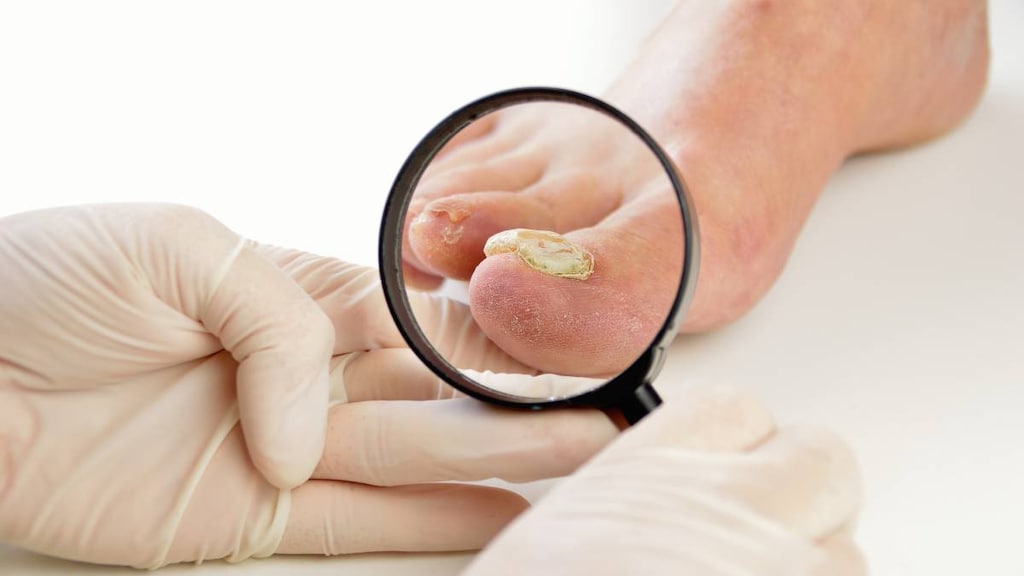What is Taltz?
Taltz is a prescription medicine used to treat:
- people 6 years of age and older with moderate-to-severe plaque psoriasis who may benefit from taking injections or pills (systemic therapy) or phototherapy (treatment using ultraviolet or UV light).
- adults with active psoriatic arthritis. Taltz can be used alone or with the medicine methotrexate.
- adults with active ankylosing spondylitis.
- adults with active non-radiographic axial spondyloarthritis with objective signs of inflammation.
It is not known if Taltz is safe and effective in children for conditions other than plaque psoriasis or in children under 6 years of age.
What is the most important information I should know about Taltz?
Taltz is a medicine that affects your immune system. Taltz may lower the ability of your immune system to fight infections and may increase your risk of infections, which can sometimes become serious.
- Your healthcare provider should check you for tuberculosis (TB) before you start treatment with Taltz.
- Your healthcare provider may treat you with medicine for TB before you begin treatment with Taltz if you have a past history of TB or have TB.
- Your healthcare provider should watch you closely for signs and symptoms of TB during and after treatment with Taltz.
Before starting Taltz, tell your healthcare provider if you:
- are being treated for an infection
- have an infection that does not go away or that keeps coming back
- have TB or have been in close contact with someone with TB
- think you have an infection or have symptoms of an infection such as:
- fever, sweats, or chills
- muscle aches
- cough
- shortness of breath
- blood in your phlegm (mucus)
- weight loss
- warm, red, or painful skin or sores on your body
- diarrhea or stomach pain
- burning when you urinate or urinate more often than normal
After starting Taltz, call your healthcare provider right away if you have any of the symptoms of infection listed above.
Do not use Taltz if you have any symptoms of infection unless you are instructed to by your healthcare provider.
See “What are the possible side effects of Taltz?” for more information about side effects.
Who should not use Taltz?
Do not use Taltz if you have had a severe allergic reaction to ixekizumab or any of the other ingredients in Taltz.
See the end of this Medication Guide for a complete list of ingredients in Taltz.
What should I tell my healthcare provider before using Taltz?
Before using Taltz, tell your healthcare provider about all of your medical conditions, including if you:
- have any of the conditions or symptoms listed in the section “What is the most important information I should know about Taltz?”
- have Crohn's disease or ulcerative colitis
- have recently received or are scheduled to receive an immunization (vaccine). You should avoid receiving live vaccines during treatment with Taltz.
- are pregnant or plan to become pregnant. It is not known if Taltz can harm your unborn baby.
- are breastfeeding or plan to breastfeed. It is not known if Taltz passes into your breast milk.
Tell your healthcare provider about all the medicines you take, including prescription and over-the-counter medicines, vitamins, and herbal supplements.
How should I use Taltz?
See the detailed Instructions for use that comes with your Taltz for information on how to prepare and inject a dose of Taltz, and how to properly throw away (dispose of) used Taltz autoinjectors and prefilled syringes.
- Use Taltz exactly as prescribed by your healthcare provider.
- For children weighing 110 pounds (50 kg) or less, Taltz must be given by a healthcare provider. Taltz will be given every 4 weeks.
- For children weighing more than 110 pounds (50 kg), if your healthcare provider decides that your caregiver may give your injections of Taltz at home, your caregiver should ask and receive training from the healthcare provider on the right way to prepare and inject Taltz. Taltz will be given every 4 weeks.
- For adults, if your healthcare provider decides that you or a caregiver may give your injections of Taltz at home, you should receive training on the right way to prepare and inject Taltz. Do not try to inject Taltz yourself, until you or your caregiver have been shown how to inject Taltz.
- Taltz comes in an autoinjector and a prefilled syringe that you or your caregiver may use at home to give injections. Your healthcare provider will decide which type of Taltz is best for you to use at home.
- Taltz is given as an injection under your skin (subcutaneous injection), in your thighs or stomach area (abdomen) by you or a caregiver. A caregiver may also give you an injection of Taltz in the back of your arm.
- Do not give an injection in an area of the skin that is tender, bruised, red or hard, or in an area of skin that is affected by psoriasis.
- Each Taltz injection should be given at a different site. Do not use the 1 inch area around your navel (belly button).
If you forget to take your dose:
- Do not miss any doses of Taltz unless your healthcare provider says it is okay. If you forget to take your Taltz dose, inject a dose as soon as you remember. Then, take your next dose at your regular scheduled time.
- If you inject more Taltz than prescribed, call your healthcare provider or go to the nearest emergency room right away.
What are the possible side effects of Taltz?
Taltz may cause serious side effects, including:
- See “What is the most important information I should know about Taltz?”
- Serious allergic reactions. If you have a severe allergic reaction, do not give another injection of Taltz. Get emergency medical help right away if you get any of the following symptoms of a serious allergic reaction:
- feel faint
- swelling of your face, eyelids, lips, mouth, tongue, or throat
- trouble breathing or throat tightness
- chest tightness
- skin rash
- Crohn's disease or ulcerative colitis (Inflammatory bowel disease) can happen during treatment with Taltz, including worsening symptoms. Tell your healthcare provider if you have new or worsening symptoms of inflammatory bowel disease during treatment with Taltz, including:
- stomach (abdomen) pain
- diarrhea with or without blood
- weight loss
The most common side effects of Taltz in adults and children include:
- injection site reactions
- upper respiratory infections
- nausea
- fungal infections
These are not all of the possible side effects of Taltz. Tell your healthcare provider about any side effect that bothers you or that does not go away. Call your doctor for medical advice about side effects. You may report side effects to FDA at 1-800-FDA-1088.
General information about the safe and effective use of Taltz
Medicines are sometimes prescribed for purposes other than those listed in a Medication Guide. Do not use Taltz for a condition for which it was not prescribed. Do not give Taltz to other people, even if they have the same symptoms you have. It may harm them. You can ask your healthcare provider or pharmacist for information about Taltz that is written for health professionals.
How should I store Taltz?
- Protect Taltz from light.
- Store Taltz in the refrigerator between 36°F to 46°F (2°C to 8°C).
- If needed, you or a caregiver may store Taltz at room temperature up to 86°F (30°C) for up to 5 days in the original carton to protect from light. Once Taltz has been stored at room temperature, do not return to the refrigerator. Throw away Taltz if it is not used within 5 days at room temperature.
- Record the date when Taltz is first removed from the refrigerator in the spaces provided on the carton.
- For the 2 or 3 autoinjector pack, remove a single autoinjector at a time leaving the remaining autoinjector(s) in the original carton in the refrigerator. Ensure the unrefrigerated Taltz is protected from light.
- Do not freeze Taltz. Do not use if Taltz has been frozen.
- Do not shake Taltz.
Keep Taltz and all medicines out of the reach of children.
What are the ingredients in Taltz?
Active ingredient: ixekizumab
Inactive ingredients: Citric Acid Anhydrous, Polysorbate 80, Sodium Chloride, Sodium Citrate Dihydrate, and Water for Injection
Not made with natural rubber latex.
For more information about Taltz, call 1-800-545-5979 (1-800-LillyRx) or go to the following website: www.taltz.com.
Instructions for use for Taltz
Taltz (tol(t)s) (ixekizumab)
injection, for subcutaneous use

Before you use the Taltz autoinjector, read and carefully follow all the step-by-step instructions.
Important information:
- Your healthcare provider or nurse should show you how to prepare and inject Taltz using the autoinjector. Do not inject yourself or someone else until you have been shown how to inject Taltz.
- You and your caregiver should read this Instructions for Use before you start using Taltz and each time you get a refill. Keep the Instructions for Use and refer to them as needed.
- Each Taltz autoinjector contains 1 dose of Taltz. The autoinjector is for one-time use only.
- The autoinjector contains glass parts. Handle autoinjector carefully. If you drop it on a hard surface, do not use it. Use a new Taltz autoinjector for your injection.
- Your healthcare provider may help you decide where on your body to inject your dose. Do not give an injection in an area of the skin that is tender, bruised, red or hard, or in an area of skin that is affected by psoriasis. Read the “choose your injection site” section of these instructions to help you choose which area can work best for you.
- If you have vision or hearing problems, do not use Taltz autoinjector without help from a caregiver.
Before you use the Taltz autoinjector, read and carefully follow all the step-by-step instructions.
Parts of the Taltz autoinjector
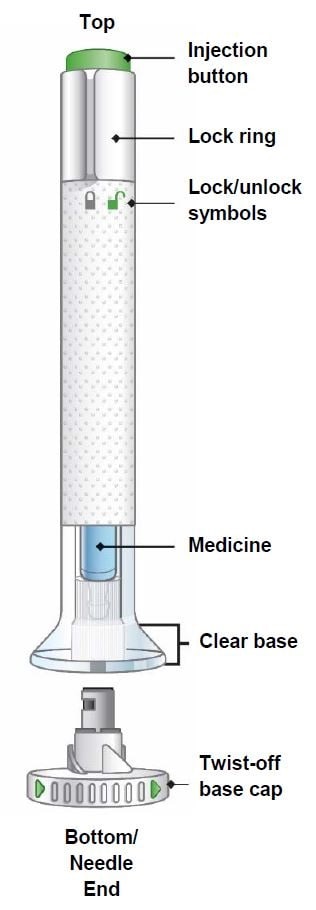
1. Get Ready
1a. Take the Taltz autoinjector from the refrigerator.
- Remove the autoinjector from the package. Put the original package with any unused autoinjectors back in the refrigerator.
- Leave the base cap on until you are ready to inject.
- Wait 30 minutes to let the autoinjector warm to room temperature before you use it.
- Do not microwave the autoinjector, run hot water over it, or leave it in direct sunlight.
- Do not shake the autoinjector.
1b. Gather the supplies needed for your injection:
- 1 alcohol wipe
- 1 cotton ball or piece of gauze
- 1 sharps disposal container. See “dispose of the used autoinjector”
1c. Inspect the autoinjector.
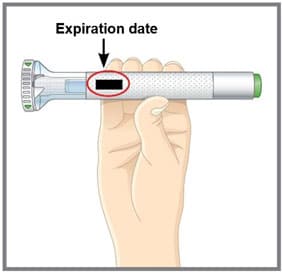
- Make sure the name Taltz appears on the label.
- The medicine inside should be clear. Its color may be colorless to slightly yellow.
Do not use the autoinjector, and dispose of as directed by your healthcare provider or pharmacist if:
- the expiration date printed on the label has passed.
- it looks damaged.
- the medicine is frozen.
- the medicine is cloudy, discolored, or has small particles. The medicine should look clear and colorless to slightly yellow.
1d. Wash your hands with soap and water before you inject Taltz.
1e. Choose your injection site.
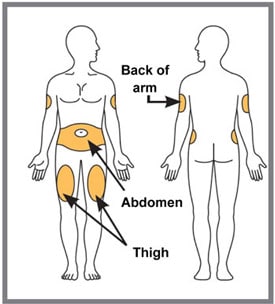
You may inject in your stomach area (abdomen) or in your thigh, or in the back of your arm. To inject in your arm, you will need someone to help you.Do not give an injection into areas where the skin is tender, bruised, red or hard, or in an area of skin that is affected by psoriasis.Do not inject within 1 inch of the navel (belly button). Alternate your injection sites.
- Do not inject in the exact same spot every time. For example, if your last injection was in your left thigh, your next injection should be in your right thigh, your abdomen, or the back of either arm.
- Talk with your healthcare provider about where on your body to best inject Taltz.
1f. Prepare your skin. Clean your injection site with an alcohol wipe. Let the injection site dry before you inject Taltz.
2. Inject Taltz
2a. Make sure the lock ring is in the lock position.
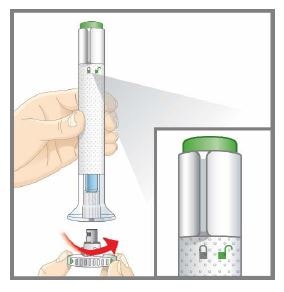
- Leave the base cap on until you are ready to inject.
- Do not touch the needle.
Twist off the base cap in the direction of the arrows.
- Throw the base cap in the trash. You will not need to put the base cap back on. If you do, you could damage the needle or stick yourself by accident.
2b. Place the clear base flat and firmly against your skin at the injection site.
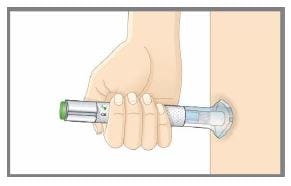
2c. While holding the clear base against your skin, turn the lock ring to the unlock position. You are now ready to inject.
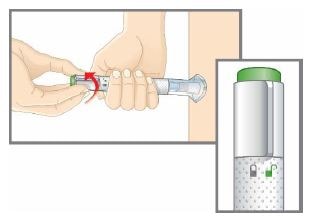
2d. Press the green injection button. There will be a loud click.
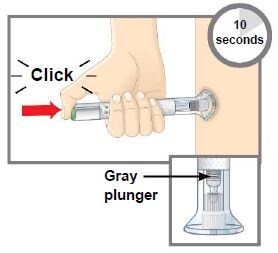
- Keep holding the clear base firmly against your skin.
- You will hear a second click in about 10 seconds after the first one. The second click tells you that your injection is complete.
- You will see the gray plunger at the top of the clear base.
- Remove the autoinjector from your skin.
- Press a cotton ball or gauze over the injection site. Do not rub the injection site, as this may cause bruising. You may have slight bleeding. This is normal.
- Do not put the base cap back on the autoinjector.
3. Dispose of (throw away) the used autoinjector.
3a. Put the used Taltz autoinjector in a FDA-cleared sharps disposal container right away after use. Do not throw away (dispose of) the Taltz autoinjector in your household trash.
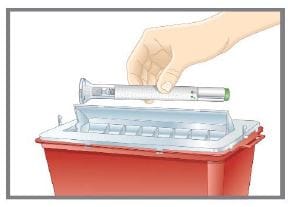
- If you do not have a FDA-cleared sharps disposal container, you may use a household container that is:
- made of a heavy-duty plastic,
- can be closed with a tight-fitting, puncture-resistant lid, without sharps being able to come out,
- upright and stable during use,
- leak-resistant, and
- properly labeled to warn of hazardous waste inside the container.
- When your sharps disposal container is almost full, you will need to follow your community guidelines for the right way to dispose of your sharps disposal container. There may be state or local laws about how you should throw away needles and syringes. For more information about safe sharps disposal, and for specific information about sharps disposal in the state you live in, go to the FDA's website at: http://www.fda.gov/safesharpsdisposal
- Do not recycle your used sharps disposal container.
Commonly asked questions and answers.
Q. What if I see bubbles in the Taltz autoinjector?
A. It is normal to have air bubbles in the autoinjector.
Q. What if there is a drop of liquid on the tip of the needle when I remove the base cap?
A. It is okay to see a drop of liquid on the tip of the needle.
Q. What if I unlocked the autoinjector and pressed the green injection button before I twisted off the base cap?
A. Do not remove the base cap. Dispose of the autoinjector and get a new one.
Q. Do I need to hold the injection button down until the injection is complete?
A. You do not need to hold the injection button down, but it may help you keep the autoinjector steady and firm against your skin.
Q. What if the needle did not retract after my injection or I am not sure that the autoinjector worked in the right way?
A. Do not touch the needle or replace the base cap. Store the autoinjector in a safe place (e.g., a household container as described in “Dispose of the used autoinjector.”) to avoid an accidental needlestick and contact Lilly (1-800-545-5979) for instructions on how to return the autoinjector.
Q. What if I hear more than 2 clicks during my injection? Did I get my complete dose?
A. You may hear a soft click right before the second loud click. This is the normal operation of the autoinjector. Do not remove the autoinjector from your skin until you hear the second loud click.
Q. How can I tell if my injection is complete?
A. After you press the green injection button, you will hear 2 loud clicks. The second click tells you that your injection is complete. You will also see the gray plunger at the top of the clear base.
If you have more questions about how to use the Taltz autoinjector:
- Call your healthcare provider
- Call Lilly at 1-800-545-5979 (1-800-Lilly-Rx)
- Visit www.Taltz.com
How should I store Taltz autoinjector?
- Protect Taltz from light.
- Store Taltz in the refrigerator between 36°F to 46°F (2°C to 8°C).
- If needed, you or a caregiver may store Taltz at room temperature up to 86°F (30°C) for up to 5 days in the original carton to protect from light. Once Taltz has been stored at room temperature, do not return to the refrigerator. Throw away Taltz if it is not used within 5 days at room temperature.
- Record the date when Taltz is first removed from the refrigerator in the spaces provided on the carton.
- For the 2 or 3 autoinjector pack, remove a single autoinjector at a time leaving the remaining autoinjector(s) in the original carton in the refrigerator. Ensure the unrefrigerated Taltz is protected from light.
- Do not freeze Taltz. Do not use if Taltz has been frozen.
- Do not shake Taltz.
Keep Taltz and all medicines out of the reach of children.
Read the full Prescribing Information and Medication Guide for Taltz inside the box to learn more about your medicine.
Instructions for use last revised 11/2019

Before you use the Taltz prefilled syringe, read and carefully follow all the step-by-step instructions.
Important information:
- Your healthcare provider or nurse should show you how to prepare and inject Taltz using the prefilled syringe. Do not inject yourself or someone else until you have been shown how to inject Taltz.
- You and your caregiver should read this Instructions for Use before you start using Taltz and each time you get a refill. Keep the Instructions for Use and refer to them as needed.
- Each Taltz prefilled syringe contains 1 dose of Taltz. The syringe is for one-time use only. Do not share or reuse your Taltz prefilled syringe. You may give or get an infection.
- Your healthcare provider may help you decide where on your body to inject your dose. Do not give an injection in an area of the skin that is tender, bruised, red or hard, or in an area of skin that is affected by psoriasis. Read the “choose your injection site” section of these instructions to help you choose which area can work best for you.
- If you have vision problems, do not use Taltz prefilled syringe without help from a caregiver.
Parts of the Taltz prefilled syringe
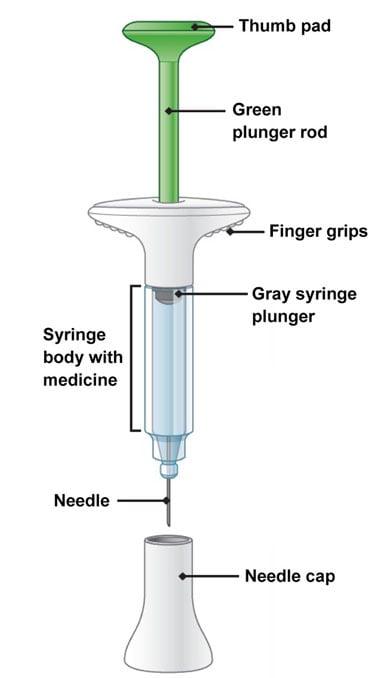
1 Get Ready
1a. Take the Taltz prefilled syringe from the refrigerator.
- Remove the prefilled syringe from the package. Put the original package with any unused syringes back in the refrigerator.
- Leave the needle cap on the syringe until you are ready to inject.
- Wait 30 minutes to let the prefilled syringe warm to room temperature before you use it.
- Do not microwave the syringe, run hot water over it, or leave it in direct sunlight.
- Do not shake the prefilled syringe.
1b. Gather the supplies needed for your injection:
- 1 alcohol wipe
- 1 cotton ball or piece of gauze
- 1 sharps disposal container. See “dispose of the used prefilled syringe.”
1c. Inspect the syringe. Leave the needle cap on the syringe until you are ready to inject.
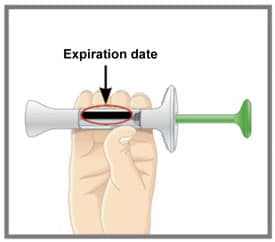
- Make sure the name Taltz appears on the label.
- The medicine inside should be clear. Its color may be colorless to slightly yellow.
Do not use the prefilled syringe, and dispose of as directed by your healthcare provider or pharmacist if:
- the expiration date printed on the label has passed.
- it looks damaged.
- the medicine is frozen.
- the medicine is cloudy, discolored, or has small particles. The medicine should look clear and colorless to slightly yellow.
1d. Wash your hands with soap and water before you inject Taltz.
1e. Choose your injection site.
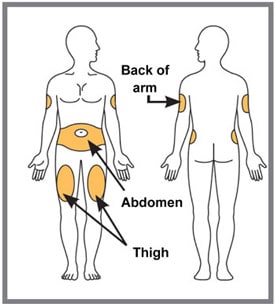
You may inject in your stomach area (abdomen) or in your thigh, or in the back of your arm. To inject in your arm, you will need someone to help you.Do not give an injection into areas where the skin is tender, bruised, red or hard, or in an area of skin that is affected by psoriasis.Do not inject within 1 inch of the navel (belly button). Alternate your injection sites.
- Do not inject in the exact same spot every time. For example, if your last injection was in your left thigh, your next injection should be in your right thigh, your abdomen, or the back of either arm.
- Talk with your healthcare provider about where on your body to best inject Taltz.
1f. Prepare your skin. Clean your injection site with an alcohol wipe. Let the injection site dry before you inject Taltz.
2 Inject Taltz
2a. Pull the needle cap off and throw it away.
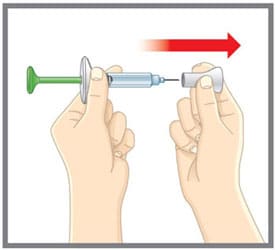
- Do not put the needle cap back on. You could damage the needle or stick yourself by accident.
- Do not touch the needle.
2b. Gently pinch and hold a fold of skin where you will inject.
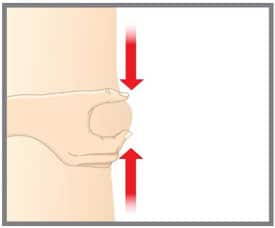
2c. Insert the needle at a 45-degree angle. Then gently let go of your skin. Make sure to keep the needle in place. Let go of your skin before you push the plunger in.
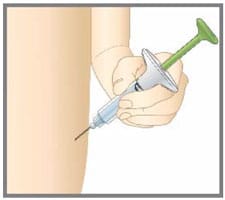
2d. Push in the plunger.
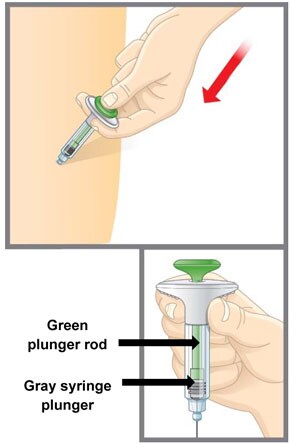
- Slowly push on the thumb pad to push the plunger all the way in until all the medicine is injected.
- The gray syringe plunger should be pushed all the way to the needle end of the syringe.
- You should see the green plunger rod show through the syringe body when the injection is complete.
- Gently remove the needle from your skin.
- Press a cotton ball or gauze over the injection site. Do not rub the injection site, as this may cause bruising. You may have slight bleeding. This is normal.
Do not put the needle cap back on the prefilled syringe.
3. Dispose of (throw away) the used prefilled syringe.
3a. Put the used Taltz prefilled syringe in a FDA-cleared sharps disposal container right away after use. Do not throw away (dispose of) the Taltz prefilled syringe in your household trash.
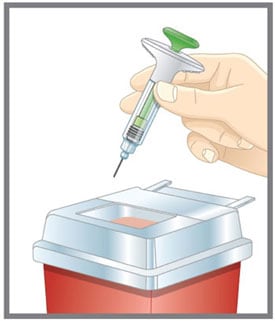
- If you do not have a FDA-cleared sharps disposal container, you may use a household container that is:
- made of a heavy-duty plastic,
- can be closed with a tight-fitting, puncture-resistant lid, without sharps being able to come out,
- upright and stable during use,
- leak-resistant, and
- properly labeled to warn of hazardous waste inside the container.
- When your sharps disposal container is almost full, you will need to follow your community guidelines for the right way to dispose of your sharps disposal container. There may be state or local laws about how you should throw away needles and syringes. For more information about safe sharps disposal, and for specific information about sharps disposal in the state you live in, go to the FDA's website at: http://www.fda.gov/safesharpsdisposal
- Do not recycle your used sharps disposal container.
Commonly asked questions and answers.
Q. What if I see air bubbles in my Taltz prefilled syringe?
A. It is normal to have air bubbles in the prefilled syringe.
Q. What if there is a drop of liquid on the tip of the needle when I remove the needle cap?
A. It is okay to see a drop of liquid on the tip of the needle.
Q. What if I cannot push in the plunger?
A. If the plunger is stuck or damaged:
- Do not continue to use the syringe
- Remove the needle from your skin
- Dispose of the syringe and get a new one
Q. How can I tell if my injection is complete?
A. When your injection is complete:
- The green plunger rod should show through the body of the syringe.
- The gray syringe plunger should be pushed all the way to the needle end of the syringe.
If you have more questions about how to use the Taltz prefilled syringe:
- Call your healthcare provider
- Call Lilly at 1-800-545-5979 (1-800-Lilly-Rx)
- Visit www.Taltz.com
How should I store Taltz prefilled syringe?
- Protect Taltz from light.
- Store Taltz in the refrigerator between 36°F to 46°F (2°C to 8°C).
- If needed, you or a caregiver may store Taltz at room temperature up to 86°F (30°C) for up to 5 days in the original carton to protect from light. Once Taltz has been stored at room temperature, do not return to the refrigerator. Throw away Taltz if it is not used within 5 days at room temperature.
- Record the date when Taltz is first removed from the refrigerator in the spaces provided on the carton.
- Do not freeze Taltz. Do not use if Taltz has been frozen.
- Do not shake Taltz.
Keep Taltz and all medicines out of the reach of children.
Read the full Prescribing Information and Medication Guide for Taltz inside the box to learn more about your medicine.
Instructions for use last revised 04/2018.


